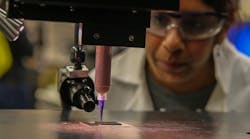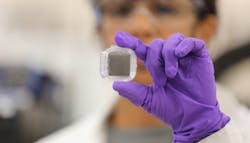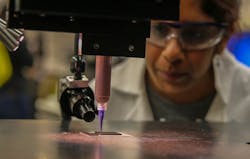A researchers team made up of engineers from Lawrence Livermore National Laboratory (LLNL) and the University of California, Santa Cruz (UCSC) have 3D printed supercapacitor electrodes capable of record-overcoming conventional tradeoffs for supercapacitors. The team devised a machine that could 3D print porous graphene aerogel structures capable of supporting ultra-high levels of manganese oxide (MnO2), a common pseudocapacitive material. (Pseudocapacitive materials store electric charge chemically and exhibit high theoretical energy capacities.) The result is a supercapacitor with the highest electric charge storage per unit of area recorded to date. It also shows significant energy density compared with other types of capacitors. The breakthrough could open avenues to using supercapacitors as ultrafast-charging power sources for devices such as cellphones, laptops, and other smaller electronics.
Supercapacitors can be charged extremely quickly, requiring just a few minutes or seconds to reach full capacity, and they retain their performance despite thousands of charging and discharging cycles. But they are rarely used as power supplies because of their relatively small storage capacity.
Researchers from Lawrence Livermore National Laboratory and UC Santa Cruz, including LLNL scientist Swetha Chandrasekaran (pictured), demonstrated 3D-printed graphene aerogel supercapacitors that resulted in record-breaking electric charge storage and “remarkable” energy density. (Photo by Julie Russell/LLNL)
The research team sidestepped this problem by loading 3D printed graphene-aerogel scaffolds with MnO2, effectively packing more energy storage capacity into a relatively small area. This addresses the typical energy storage vs. discharging/charging rate tradeoff made with supercapacitors and creates versions with energy densities approaching that of some conventional batteries.
“We’re trying to get the best of both worlds,” says LLNL materials engineer Eric Duoss. “The remarkable part about this work is that all that surface area is accessible and active, so you get amazing volumetric and gravimetric properties that can take on a wide variety of shape or form factors for applications.
The team used a chemical deposition method to load the porous 3D-printed structures with up to 180 milligrams of MnO2. Although this level of mass loading typically degrades performance due to sluggish ion diffusion, depositing the pseudocapacitive material inside and outside the structures let the team reach unprecedented levels of loading without compromising performance—about 100 times higher than others have achieved. Researchers said the feat would be impossible without 3D printing and points toward more commercially feasible energy storage materials for a broad range of applications.
Loading the 3D-printed lattice structures with manganese oxide let researchers pack more energy storage capacity into a relatively small area, overcoming conventional tradeoffs for supercapacitors and approaching energy densities equal to some conventional batteries.
Traditionally, supercapacitor electrodes are built with thin, carbon-based films. To reach higher capacitance and energy density, engineers stack thin-film electrodes, adding weight and costs. However, the ion diffusion demonstrated in the LLNL/UCSC 3D-printed supercapacitor electrodes suggests they could be made thicker without degrading performance. Researchers also discovered the electric charge storage per unit increased linearly along with MnO2 loading and electrode thickness, suggesting widespread commercial potential and indicating that 3D printing an entire electrode at once could revolutionize the way supercapacitors are made.
“Our 3D-printed structures are not limited by surface area because we have a lot of accessible macropores,” says UCSC graduate student and co-lead author Bin Yao. “These pores are important for depositing manganese oxide and efficient ion diffusion. We can have a thick electrode but still retain good conductivity and ion diffusion. Usually, as it gets thicker, capacitance plateaus, especially at high charging rates. But with a 3D structure, we can use higher charges. Even if we increase the thickness, it won’t change the gravimetric value.”
The advantage to 3D printing is that researchers can tailor the pore size, adjust the parameters, and fabricate these electrodes quickly.



